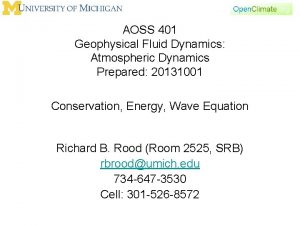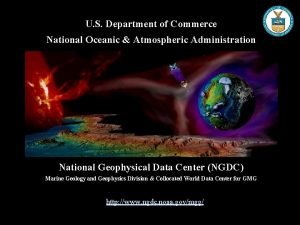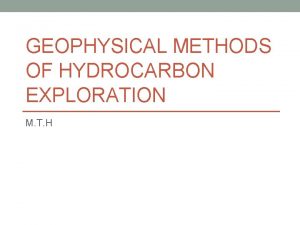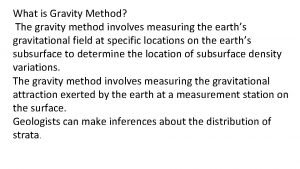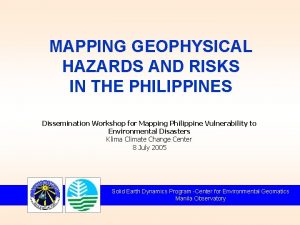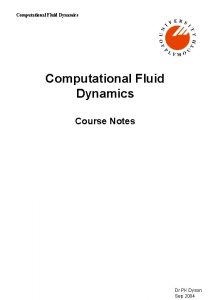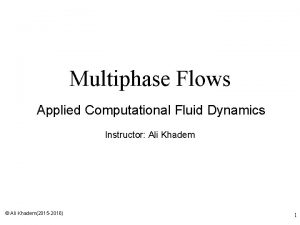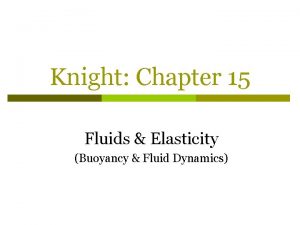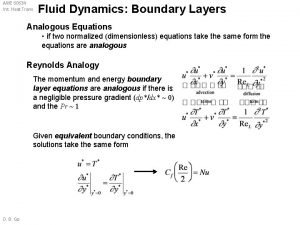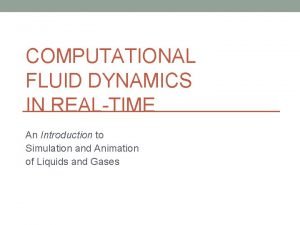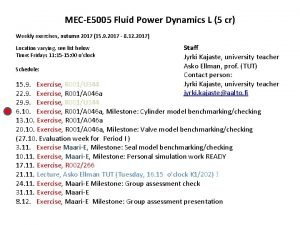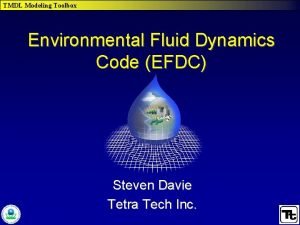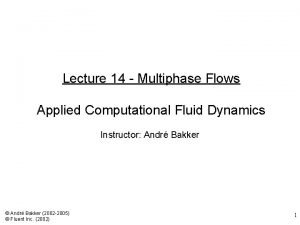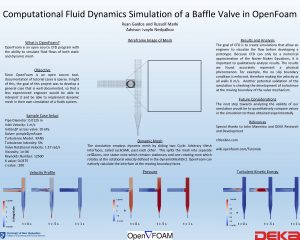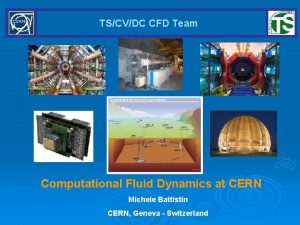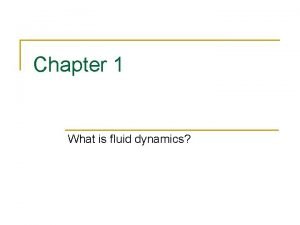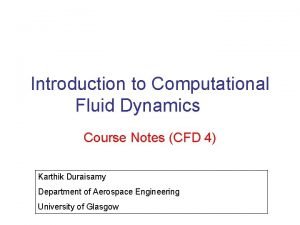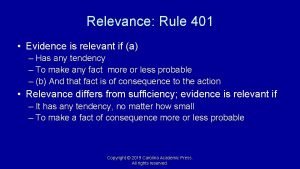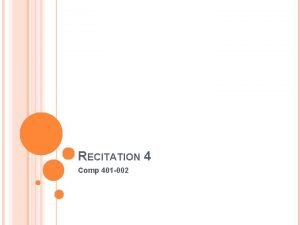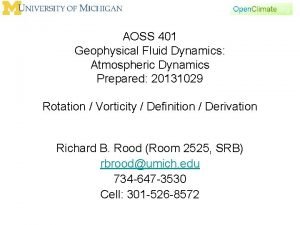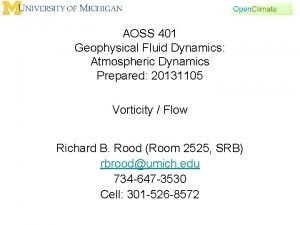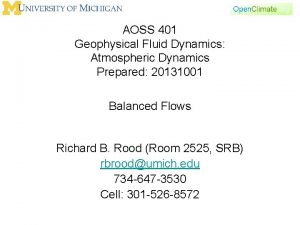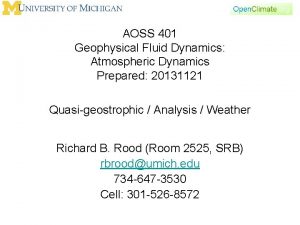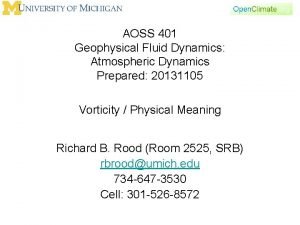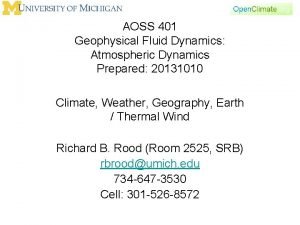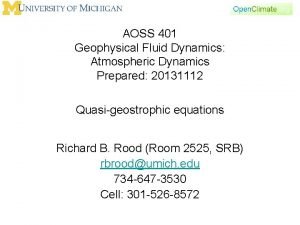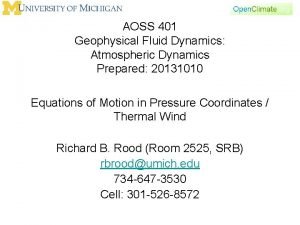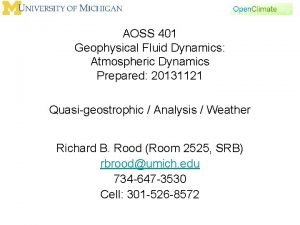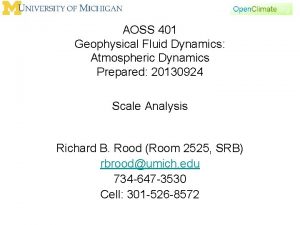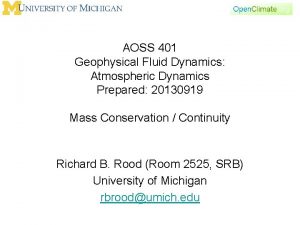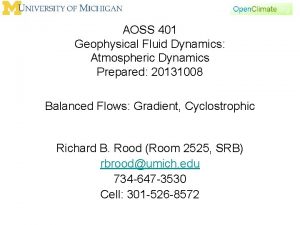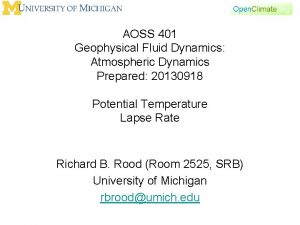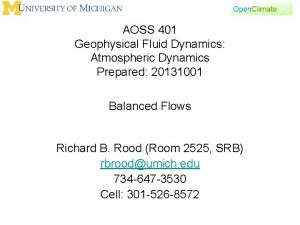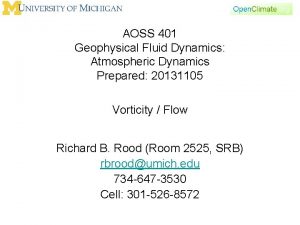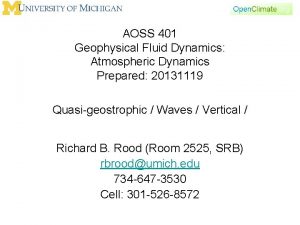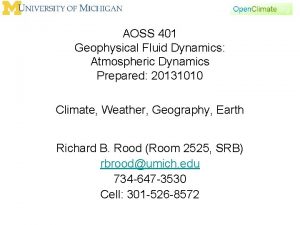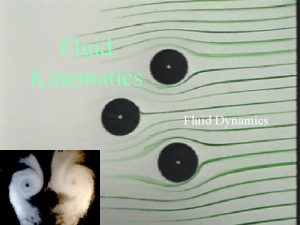AOSS 401 Geophysical Fluid Dynamics Atmospheric Dynamics Prepared
















































- Slides: 48

AOSS 401 Geophysical Fluid Dynamics: Atmospheric Dynamics Prepared: 20131010 Equations of Motion in Pressure Coordinates / Thermal Wind Richard B. Rood (Room 2525, SRB) rbrood@umich. edu 734 -647 -3530 Cell: 301 -526 -8572

Class News • Ctools site (AOSS 401 001 F 13) • Second Examination on December 10, 2013 • Homework – Watch for Ctools / Email

Weather • National Weather Service – Model forecasts: • Weather Underground – Model forecasts: • NCAR Research Applications Program

Outline • Equations of Motion in Pressure Coordinates • Thermal wind • Revisit the Tour of the Earth – Vertical structure

Return to Pressure Coordinates • In the coming weeks, we will work mostly with the equations of motion in pressure coordinates • We have already derived and used extensively the horizontal momentum equations in pcoordinates • Remaining equations: – – Thermodynamic equation Continuity equation Vertical momentum equation (hydrostatic balance) Plus, what to do with the material derivative?

Our approximated horizontal momentum equations (in p coordinates) No viscosity, no metric terms, no cos-Coriolis terms Subscript h: horizontal Subscript p: constant p surfaces! Sometimes subscript is omitted, tells you that this is on p surfaces

Geostrophic Wind (in p coordinates) Component form: Vector form: Here we implicitly assume that the partial derivatives in x and y direction are computed on constant p surfaces. Advantage of the p coordinates: Simplicity of the equation! Density no longer appears explicitly.

What do we do with the material derivative? By definition: Example: Total derivative of the temperature on constant z surfaces (subscript omitted)

What do we do with the material derivative when using p in the vertical? By definition: Total derivative DT/Dt on constant pressure surfaces: (subscript omitted)

Think about vertical motion in pressure coordinates • For upward motion, what is the sign of ‘w’ (vertical velocity in height coordinates)? • What is the sign of ω for upward vertical motion? Remember: • And pressure decreases with height… • What is the sign of Dp/Dt (change in pressure following the motion) for upward motion? For downward motion?

Think about vertical motion in pressure coordinates • Something to keep in the back of your mind… • ω is negative for upward motion • ω is positive for downward motion

Thermodynamic equation (in p coordinates) From Holton, we can Derive two forms of thermodynamic equation Expand the material derivative and use

Thermodynamic equation (in p coordinates) Collect terms in ω and divide through by cp Use the equation of state (ideal gas law)

Thermodynamic equation (in p coordinates) Define the static stability parameter Sp What is static stability?

Thermodynamic equation (in p coordinates) If there is no horizontal advection, then the time rate of change of temperature is due to…? Adiabatic rising/sinking Diabatic heating (radiation, condensation) http: //www. wunderground. com/modelmaps/maps. asp? model=NAM&domain=US

Continuity equation in z coordinates: in p coordinates: We could try to derive the pressure-coordinate version from the height-coordinate equation (as we did with the pressure gradient force in the horizontal momentum equations), but…

Re-deriving the continuity equation in p coordinates It turns out to be easier to re-derive it from mass conservation Start with an air parcel with volume: V= x y z z Apply the hydrostatic y x equation p= - g z to express the volume element as V= - x y p/( g) The mass of this fluid element is: M = V= - x y p/( g) = - x y p/g

Re-deriving the continuity equation in p coordinates z ( M = - x y p/g) x y Use the product rule Differential calculus Take the limit Continuity equation in p coordinates

Continuity equation(in p coordinates) This form of the continuity equation contains no reference to the density field and does not involve time derivatives. The simplicity of this equation is one of the chief advantages of the isobaric system. Ease of computing vertical motion from convergence/divergence is another…

Hydrostatic equation (in p coordinates) Hydrostatic equation in z-coords Rearrange (and assume g constant) Apply the equation of state Replaces the vertical momentum equation

Approximated equations of motion in pressure coordinates

In the derivation of the equations in pressure coordinates: • Have used conservation principles. • Have relied heavily on the hydrostatic assumption. • Required that conservation principles hold in all coordinate systems. • Plus we did some implicit scaling (metric terms, cosine coriolis terms dropped out).

The thermal wind • Connecting horizontal temperature structure to vertical wind structure in a balanced atmosphere

Equations of motion in pressure coordinates (plus hydrostatic and equation of state)

Geostrophic wind

Hydrostatic Balance

Schematic of thermal wind. Thickness of layers related to temperature. Causing a tilt of the pressure surfaces. from Brad Muller

What is a tactic for exploring vertical behavior?

Geostrophic wind Take derivative wrt p. Links horizontal temperature gradient with vertical wind gradient.

Thermal wind p is an independent variable, a coordinate. Hence, x and y derivatives are taken with p constant.

A excursion to the atmosphere. Zonal mean temperature - Jan approximate tropopause south (summer) north (winter)

A excursion to the atmosphere. Zonal mean temperature - Jan ∂T/∂y ? south (summer) north (winter)

A excursion to the atmosphere. Zonal mean temperature - Jan ∂T/∂y ? <0 <0 >0 <0 south (summer) north (winter)

A excursion to the atmosphere. Zonal mean temperature - Jan ∂T/∂y ? ∂ug/∂p ? <0 <0 <0 >0 >0 <0 >0 south (summer) >0 north (winter) <0 <0

A excursion to the atmosphere. Zonal mean wind - Jan south (summer) north (winter)

Relation between zonal mean temperature and wind is strong • This is a good diagnostic – an excellent check of consistency of temperature and winds observations. • We see the presence of jet streams in the east-west direction, which are persistent on seasonal time scales. • Is this true in the tropics?

Thermal wind

Thermal wind

Thermal wind

Thermal wind ?

From Previous Lecture Thickness Note link of thermodynamic variables, and similarity to scale heights calculated in idealized atmospheres Z 2 -Z 1 = ZT ≡ Thickness - is proportional to temperature is often used in weather forecasting to determine, for instance, the rain-snow transition.

Similarity of the equations There is clearly a relationship between thermal wind and thickness.

Schematic of thermal wind. Thickness of layers related to temperature. Causing a tilt of the pressure surfaces. from Brad Muller

Another excursion into the atmosphere. X X 850 h. Pa surface X 300 h. Pa surface from Brad Muller

Another excursion into the atmosphere. X X X 850 h. Pa surface 300 h. Pa surface from Brad Muller

Another excursion into the atmosphere. 850 h. Pa surface 300 h. Pa surface from Brad Muller

Another excursion into the atmosphere. 850 h. Pa surface 300 h. Pa surface from Brad Muller

Summary of Key Points • The weather and climate of the Earth are responses to basic attributes (geometry) of energy sources. • The patterns of weather and climate that we see are not random or accidental. – Basic redistribution of energy – Determined by characteristics of Earth – especially relation of Earth to Sun and rotation – Determined by geography – Determined by surface energy characteristics • Dynamics of atmosphere and ocean, though complex, organize the air and water into features that we can characterize quantitatively and predict • There is strong consistency between energy, thermodynamic variables, and motion (momentum)
 Geophysical fluid dynamics
Geophysical fluid dynamics Ngdc
Ngdc Gravity method of geophysical exploration
Gravity method of geophysical exploration Reservoir geophysical corporation
Reservoir geophysical corporation Gravity corrections
Gravity corrections Tsunami sa basilan at romblon
Tsunami sa basilan at romblon Movement of body fluids
Movement of body fluids Is synovial fluid extracellular fluid
Is synovial fluid extracellular fluid Ecf icf and interstitial fluid
Ecf icf and interstitial fluid Fluid thrill amount
Fluid thrill amount P1-p2
P1-p2 Interstitial vs intracellular
Interstitial vs intracellular Fluid statics deals with fluid at rest
Fluid statics deals with fluid at rest Fluid mechanics chapter 4 solutions
Fluid mechanics chapter 4 solutions Transcellular fluid
Transcellular fluid Fluid dynamics
Fluid dynamics Computational fluid dynamics
Computational fluid dynamics Fluid dynamics
Fluid dynamics Computational fluid dynamics
Computational fluid dynamics Fluid dynamics
Fluid dynamics Fluid dynamics animation
Fluid dynamics animation Fluid power dynamics
Fluid power dynamics Euler's equation in fluid mechanics
Euler's equation in fluid mechanics Computational fluid dynamics
Computational fluid dynamics Environmental fluid dynamics code
Environmental fluid dynamics code Computational fluid dynamics
Computational fluid dynamics Fluid dynamics
Fluid dynamics Openfoam baffle
Openfoam baffle Computational fluid dynamics
Computational fluid dynamics Fluid dynamics definition
Fluid dynamics definition Colloid osmotic pressure
Colloid osmotic pressure Cfd lecture notes
Cfd lecture notes Nia 401
Nia 401 Melinex pet
Melinex pet 401 relevance
401 relevance Quantas prendas faltam para a turma 401 empatar com a 402
Quantas prendas faltam para a turma 401 empatar com a 402 Ge 401
Ge 401 Ce 401
Ce 401 401 stitch type
401 stitch type 401 branard st
401 branard st Lsp401
Lsp401 Faa p-401
Faa p-401 Stitch type 401
Stitch type 401 Hinário adventista 401
Hinário adventista 401 Where should charts with food code 3-401 be displayed
Where should charts with food code 3-401 be displayed Ce-401
Ce-401 Comp 401
Comp 401 Jul 401 english
Jul 401 english Bmb 401 umiami
Bmb 401 umiami
